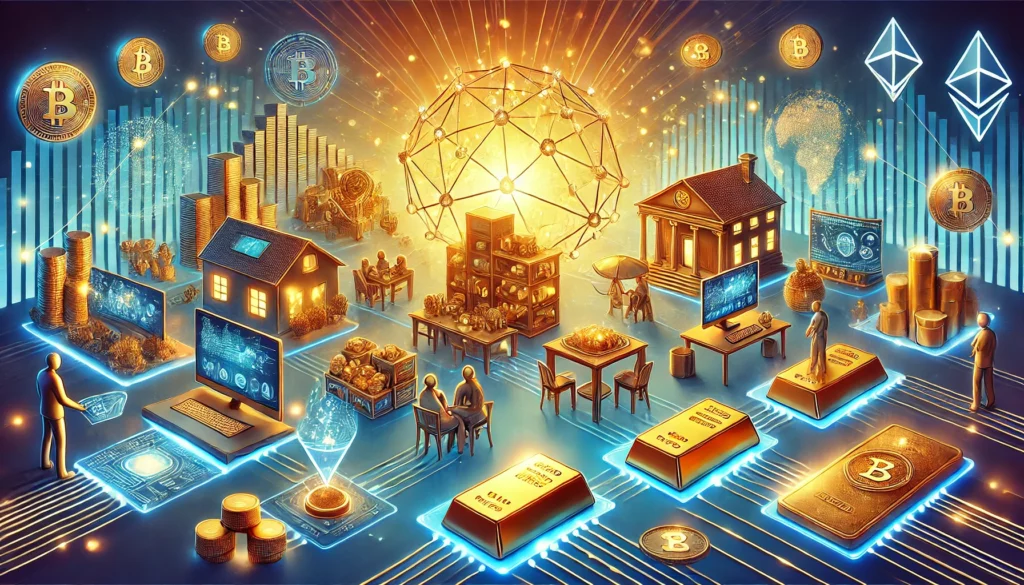In the digital age, where technology continuously reshapes how we interact with the world, tokenization is emerging as a revolutionary concept poised to redefine ownership and investment. At its core, tokenization involves converting tangible or intangible assets into digital tokens on a blockchain, enabling them to be divided into fractional ownership. This process makes high-value assets, such as real estate, art, and commodities, more accessible to a broader audience. The tokenization trend is not only creating new opportunities for investors but is also transforming industries by bringing liquidity, transparency, and efficiency to traditionally complex and exclusive markets.
Tokenization has roots in the early development of blockchain, where cryptocurrencies demonstrated how digital tokens could hold and transfer value securely. As the technology evolved, innovators recognized its potential to represent physical and financial assets, paving the way for tokenized securities, real estate, and even unique items like sports memorabilia and digital art. Today, this concept is expanding rapidly, offering investors new ways to diversify their portfolios while reshaping the foundations of ownership and trade.
Understanding Tokenized Assets
Tokenized assets are digital representations of ownership tied to real-world or intangible items. Each token functions as a share in the underlying asset and can be securely traded on a blockchain network. Unlike traditional investment models, where entire assets must be bought and sold, tokenization allows individuals to own fractions of an asset. This fractionalization opens doors to a more inclusive investment landscape, enabling people with smaller budgets to access high-value items like luxury real estate or fine art.
For example, consider a property valued at $10 million. Traditionally, purchasing this property would require either a significant amount of capital or pooling resources through complex investment mechanisms. With tokenization, this property could be divided into one million tokens, each representing a $10 share. Investors can then buy as many tokens as they wish, aligning their investments with their financial capabilities.
Tokenization Across Industries
Tokenization is already making waves in various sectors, from commodities and real estate to collectibles and financial instruments. Its versatility has allowed it to impact multiple industries, each benefiting uniquely from the transparency, security, and efficiency that blockchain technology provides.
1. Commodities
Commodities like gold, oil, and agricultural products are integral to the global economy, yet they often remain out of reach for retail investors due to high costs and logistical challenges. Tokenization changes this by enabling fractional ownership and digital trading of these assets.
For instance, platforms that tokenize gold allow investors to own small fractions of physical reserves stored in secure vaults. This process not only democratizes access to commodities but also enhances their liquidity by allowing tokens to be traded on blockchain-based marketplaces.
2. Real Estate
Real estate has long been viewed as a reliable investment vehicle, but high entry costs and limited liquidity have often restricted participation. Tokenization solves these challenges by allowing properties to be divided into digital shares. Investors can purchase tokens representing ownership in a property and benefit from rental income or appreciation, all without the need to directly manage the asset.
Platforms like RealT have already made strides in this space, offering tokenized ownership of residential and commercial properties. This model not only reduces barriers to entry but also streamlines the buying and selling process, making real estate investments more accessible and efficient.
3. Collectibles and Art
The art and collectibles market has traditionally been reserved for wealthy investors who can afford to spend millions on a single painting or rare item. Tokenization is democratizing these markets by allowing individuals to own fractions of valuable assets. For instance, companies like Masterworks tokenize iconic artworks, enabling investors to buy shares and benefit from the asset’s appreciation over time.
Similarly, sports memorabilia, rare wines, and vintage cars are being tokenized, creating opportunities for enthusiasts and investors alike. Tokenization also provides a transparent record of ownership and provenance, reducing fraud and ensuring authenticity.
4. Financial Instruments
Financial products like bonds, equities, and mutual funds are being tokenized to enhance efficiency and accessibility. Tokenized bonds, for example, can be traded instantly on blockchain platforms, reducing settlement times and costs. This shift is particularly impactful for retail investors, who gain access to instruments that were previously dominated by institutional players.
Benefits of Tokenized Assets
The appeal of tokenized assets lies in their ability to address many of the limitations inherent in traditional investment models. By leveraging blockchain technology, tokenization offers a range of advantages that are reshaping the financial landscape.
1. Accessibility
Tokenization lowers barriers to entry, enabling individuals to invest in high-value assets with minimal capital. This inclusivity allows more people to participate in markets that were traditionally exclusive to the wealthy.
2. Liquidity
Assets like real estate and fine art have historically been illiquid, requiring months or years to sell. Tokenization transforms these assets into tradeable tokens, providing investors with greater flexibility and liquidity.
3. Transparency and Security
Blockchain technology ensures that ownership records and transactions are immutable and transparent. This reduces the risk of fraud and fosters trust between buyers and sellers.
4. Cost Efficiency
By eliminating intermediaries and automating processes through smart contracts, tokenization reduces administrative costs and transaction fees.
5. Portfolio Diversification
Investors can use tokenization to diversify their portfolios across asset classes, geographies, and industries, reducing risk and increasing potential returns.
Challenges to Overcome
While tokenization offers immense potential, it is not without challenges. For widespread adoption to occur, several obstacles need to be addressed.
1. Regulatory Uncertainty
Tokenized assets exist at the intersection of traditional finance and blockchain technology, making them subject to varying regulations across jurisdictions. Governments must establish clear legal frameworks to support this emerging market.
2. Scalability
Blockchain networks must handle large transaction volumes efficiently to support global adoption of tokenized assets. Advances in scalability solutions are critical to overcoming this barrier.
3. Market Maturity
The tokenization market is still in its infancy, with limited platforms and liquidity compared to traditional financial systems. This immaturity can deter risk-averse investors.
4. Investor Education
Many potential investors lack understanding of blockchain and tokenization, which can hinder adoption. Education and outreach are essential to bridge this knowledge gap.
5. Technological Interoperability
To achieve seamless trading of tokenized assets, blockchain networks must work together, ensuring compatibility and interoperability.
Looking Ahead: The Future of Tokenized Assets
As blockchain technology continues to mature, tokenized assets are expected to become a cornerstone of the global economy. Several trends are shaping the future of this space:
- Integration with DeFi: Decentralized finance platforms are incorporating tokenized assets, enabling new use cases like collateralized loans and yield farming.
- Institutional Participation: Large financial institutions are beginning to explore tokenization for their portfolios, lending credibility to the market and attracting more participants.
- Expansion into New Markets: Tokenization is extending into emerging asset classes, such as carbon credits, renewable energy projects, and intellectual property.
- Cross-Border Trading: With the development of global standards and regulatory frameworks, tokenized assets will become increasingly accessible across borders, fostering a truly global market.
Final Thoughts
The tokenization of assets represents a paradigm shift in how we perceive and participate in ownership and investment. By breaking down barriers and making high-value assets more accessible, tokenization is democratizing opportunities and fostering a more inclusive financial ecosystem. As blockchain technology evolves and adoption increases, tokenized assets are poised to reshape industries, from commodities and real estate to art and collectibles. For investors and innovators alike, the future of tokenization promises a dynamic and equitable marketplace where ownership is redefined, and possibilities are limitless.


